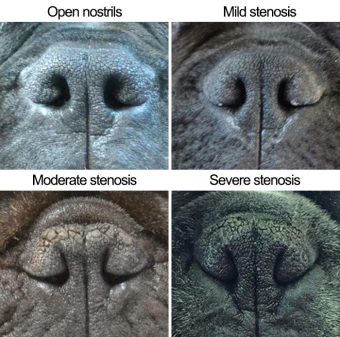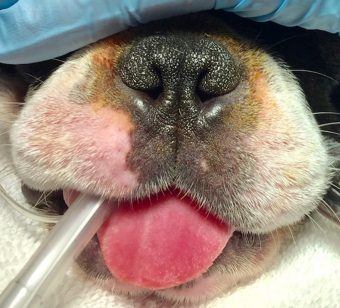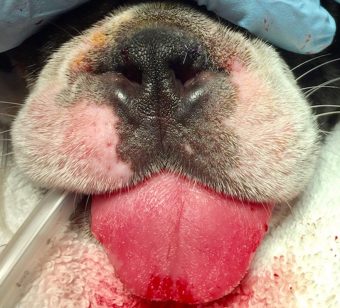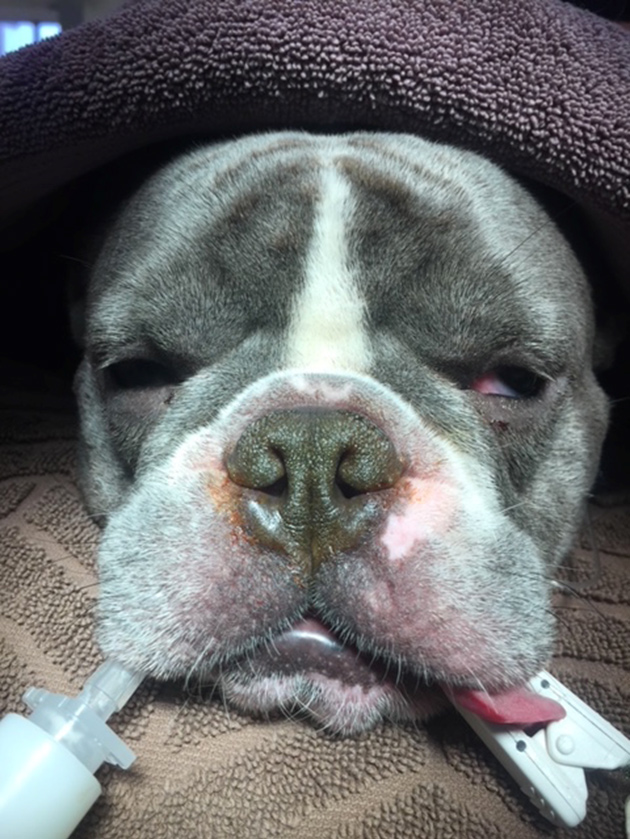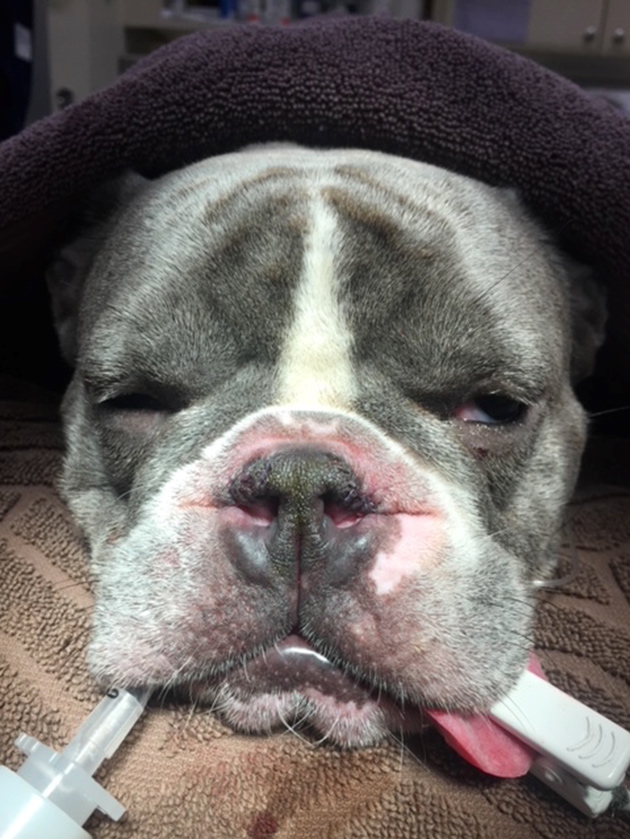BOAS Surgery
Brachycephalic Obstructive Airway Syndrome or BOAS
Overview
Brachycephalic airway syndrome is a term that describes a set of anatomical features in a dog’s airway that cause increased resistance to movement of air.
Brachycephalic refers to dogs with shortened skull features including a shortened snout.
Over time, we (humans), have bred certain breeds of dogs to have the cute, endearing, compact face that we all know and love in dogs such as French bulldogs, Pugs, Boston Terriers, and English Bulldogs etc (see photo below).
Although they are adorable, the anatomy of their nose, airway and throat can pose significant problems with breathing, especially during activity or warm weather. Noticeable signs of dogs with an affected airway consist of snoring, gagging, snorting, sleep apnea, collapse, cyanosis (bluish color to the tongue), vomiting, regurgitation and difficulty exercising despite a willingness to exercise.
Overtime, we have come to consider these signs “normal” and “expected” for these breeds of dogs, which leaves many undiagnosed and untreated. The reality is that it is never “normal” for any breed of dog to have audible noises like snorting/gagging when doing a simple task such as short walks outside, vomiting/choking after eating/drinking or snoring so loudly, the household is disturbed! Fortunately, options do exist to help improve the quality of life for these animals if their signs are recognized and addressed appropriately.
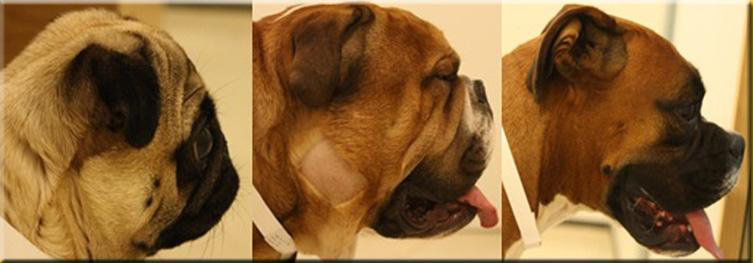
Left: Pug, Center: Bulldog, Right: Boxer
Image Credit: DogsTrust
This image depicts three different breeds of dogs with brachycephalic structure (broad, short skull).
Notice the significant flattening of the face and difference in the nose length of these breeds. A shorter, compact nose/face compresses their anatomy into a smaller space leading to signs of BOAS.
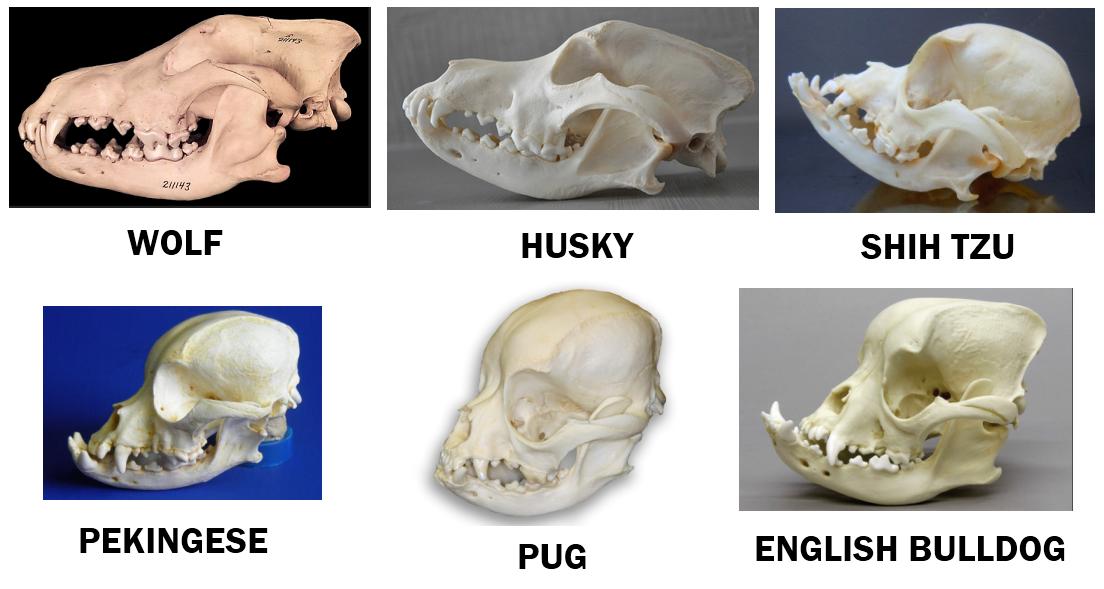
Image Credit: Imgur
This image shows the anatomic differences in skull shape between different breeds of dogs. Notice the shortened nose and underbite (longer lower jaw) in some of these breeds.
The Condition
Brachycephalic Obstructive Airway syndrome or BOAS is comprised of 5 classic airway changes. Dogs may have one or multiple of these changes.
- Stenotic nares (small or inverted nostrils, that limit air movement through the nose)
- Elongated and/or thickened soft palate (extra long/thick tissue that hangs down in the back of the throat that causes gagging, breathing noises)
- Everted laryngeal saccules (“balloon” type structures that extend outwards in the throat area that limits air movement and can cause noisy breathing)
- Hypoplastic trachea (smaller than normal trachea or air tube leading to the lungs). This is important as it is not correctable with surgery and if present, means airflow will always be restricted to some degree). This is more common in English bulldogs.
- Laryngeal collapse (weakness of the cartilages near the Adams apple) Other factors, not on this list that are associated with BOAS in some breeds include neck girth ratio (neck width), body condition score/obesity (body weight), nasopharyngeal abnormalities (20% of dogs) and bronchial collapse (87% dogs, collapse of small airways in the lungs).
In addition to these airway changes, dogs can also have abdominal issues consisting of salivation, vomiting and regurgitation. It has been shown that up to nearly 80% of dogs with brachycephalic syndrome have gastrointestinal changes consisting of acid reflux, hiatal hernia, pyloric stenosis, stomach/esophageal inflammation, which is secondary to the changes in pressure created by the abnormal airway. Many of these dogs vomit regularly. When their airway resistance is corrected with surgery, the abdominal signs tend to improve as well.
Treatment
Surgery for BOAS first involves a detailed history to understand the extent of symptoms a particular dog may have and to provide clear expectations after surgery. Every dog has different anatomy, therefore, surgery outcomes are very different for each animal.
Following a history, an airway exam by a surgeon familiar with the complexity of this condition is performed. The exam is performed under anesthesia to allow us to examine the very back of the throat. While under anesthesia, the nose, throat and mouth are cleaned and the proposed surgery is performed.
Surgery involves removing the excess tissue that is present causing the obstruction in the airway and typically includes the following: nares resection (widening of the nostrils), palatoplasty (shortening and thinning the soft palate) and sacculectomy (removing the saccules or “balloon” structures that are in the back of the throat). Most dogs require all three procedures.
After surgery, dogs are treated with medication for pain and are monitored in the hospital for 8-24 hours. Once released from the hospital, they should rest for 1 week, which means no activity that causes heavy breathing or barking. This means no play and very light, short walks. They are fed soft food for a few days after surgery. I prefer to start these animals on a stomach acid reducer medication before surgery and a low fat intestinal dog food that can also help to improve their abdominal signs while they are recovering.
After 2 weeks of recovery, it is expected that dogs will have a significant improvement in their signs or even resolution of some symptoms such as sleep apnea, snorting etc. It is important to remember that due to breeding, we can never make them completely normal like a dog with a longer snout, however, we can improve their ability to breathe, dramatically improving their quality of life and improve their ability to exercise. It is important to keep these animals in good physical condition throughout their life, as any obesity will put pressure on their chest and neck and can exacerbate their signs.
Before nose correction
After nose correction
Example of stenotic nares correction (widening of the nostrils). Note that on the right photo, the nostrils are round instead of inverted.
Before Nose Correction
After Nose Correction
Brachycephalic syndrome is a very prevalent and under recognized medical condition in many breeds of dogs. With education, we can improve breeding standards for these animals, recognize and treat affected dogs in effort to provide them an improved quality of life.
Apply for examinations, and furher information: call: +36-62-652-371
Apply for examinations, and furher information: call: +36-62-652-371
or email: szegediallatorvos@gmail.com
2024.06.10.
